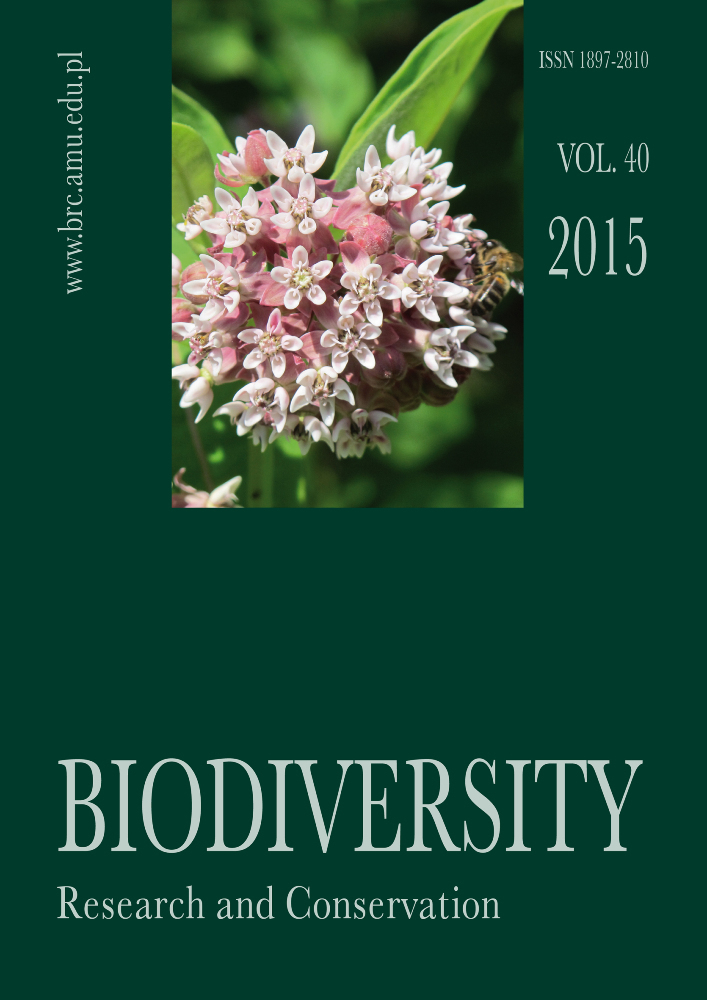Abstract
The object of the study is the distribution and spatial pattern of black cherry Padus serotina Ehrh. population and the impact of landscape structure on the expansion of this alien species in the suburban zone of the city, where the land-use has rapidly been transforming recently. The population of black cherry expands centrifugally, spreading from fringes of the city to outer zones of the agglomeration with more agricultural character. Individuals of P. serotina are distributed in clusters in this area. The maximum observed population density reaches 371/ha (mean 11.3/ha for colonized plots). The main factor influencing the landscape invasibility is cessation of agriculture. Although the first sources of spread of P. serotina are localities in forests, where 46% of the total number of individuals are concentrated, nevertheless, the largest group of juveniles (48%) was found on abandoned farmlands. Over 90% of all youngest individuals were recorded at a distance of up to 100 m from older ones. Chances of isolated occurrence are small and the probability of the colonization is strongly dependent on the occupation of adjacent areas by the species. Black cherry disperses, primarily, according to a spatial pattern of phalanxes, by occupying areas immediately adjacent to places previously colonized and then filling the available habitats. Long-distance dispersal seems to play a minor role for its expansion. Autocorrelation and diffusion models of spread should be taken into account in preventing further expansion of black cherry and planning conservation measures in natural protected areas.
References
Chmura D. 2004. Penetration and naturalisation of invasive alien plant species (neophytes) in woodlands of the Silesian Upland (Southern Poland). Nat. Conserv. 60: 3-11.
Deckers B., Verheyen K., Vanhellemont M., Maddens E., Muys B. & Hermy M. 2008. Impact of avian frugivores on dispersal and recruitment of the invasive Prunus serotina in an agricultural landscape. Biol. Invasions 10: 717-727.
Dormann C. F. 2007. Effects of incorporating spatial autocorrelation into the analysis of species distribution data. Global Ecol. Biogeogr. 16: 129-138.
Faliński J. B. 1968. Stadia neofityzmu i stosunek neofitów do innych komponentów zbiorowiska. Mater. Zakł. Fitosoc. Stos. Uniw. Warszawskiego 25: 15-23.
Halarewicz A. 2011a. Odnawianie się czeremchy amerykańskiej (Prunus serotina Ehrh.) na siedliskach borowych. Sylwan 155(8): 530-534.
Halarewicz A. 2011b. Przyczyny i skutki inwazji czeremchy amerykańskiej Prunus serotina w ekosystemach leśnych. Leśne Pr. Bad. 72(3): 267-272.
Hastings A., Cuddington K., Davies K. F., Dugaw C. J., Elmendorf S., Freestone A., Harrison S., Holland M., Lambrinos J., Malvadkar U., Melbourne B. A., Moore K., Taylor C. & Thomson D. 2005. The spatial spread of invasions: new developments in theory and evidence. Ecol. Letters 8: 91-101.
Higgins S. I. & Richardson D. M. 1996. A review of models of alien plant spread. Ecol. Model. 87(1-3): 249-265.
Jackowiak B. 1998. Struktura przestrzenna flory dużego miasta. Studium metodyczno-problemowe. Prace Zakładu Taksonomii Roślin UAM w Poznaniu 8: 1-227. Bogucki Wyd. Nauk., Poznań.
Křivánek M., Pyšek P. & Jarošík V. 2006. Planting history and propagule pressure as predictors of invasion by woody species in a temperate region. Conserv. Biol. 20(5): 1487-1498.
Nathan A. & Muller-Landau H. C. 2000. Spatial patterns of seed dispersal, their determinants and consequences for recruitment. Tree 15(7): 278-285.
Pearson R. G. & Dawson T. P. 2005. Long-distance plant dispersal and habitat fragmentation: identifying conservation targets for spatial landscape planning under climate change. Biol. Conserv. 123(3): 389-401.
Pyšek P., Jarošik V. & Kučera T. 2002. Patterns of invasion in temperate nature reserves. Biol. Conserv. 104: 13-24.
Richardson D. M. & Pyšek P. 2006. Plant invasions: merging the concepts of species invasiveness and community invisibility. Prog. Phys. Geog. 30(3): 409-431.
Rouget M. & Richardson D. M. 2003. Understanding patterns of plant invasion at different spatial scales: quantifying the roles of environment and propagule pressure. In: L. E. Child, J. H. Brock, G. Brundu, K. Prach, P. Pyšek, P. M. Wade & M. Williamson (eds.). Plant invasions: ecological threats and management solutions, pp. 3-15. Backhuys Publishers, Leiden.
Sebert-Cuvillier E., Simon-Goyheneche V., Paccaut F., Chabrerie O., Goubet O. & Decocq G. 2008. Spatial spread of an alien tree species in a heterogeneous forest landscape: a spatially realistic simulation model. Landscape Ecol. 23: 787-801.
Stypiński P. 1977. Odnawianie się czeremchy amerykańskiej (Padus serotina (Ehrh.) Borkh.) w lasach na Pojezierzu Mazurskim. Sylwan 121(10): 47-57.
Thiele J. & Otte A. 2008. Invasion patterns of Heracleum mantegazzianum in Germany on the regional and landscape scales. J. Nat. Conserv. 16(2): 61-71.
Thuiller W., Alberta C., Araújob M. B., Berryc P. M., Cabezad M., Guisane A., Hic klerf T., Mid gleyg G. F., Patersonc J., Schurrh F. M., Sykesf M. T. & Zimmermanni N. E. 2008. Predicting global change impacts on plant species’ distributions: Future challenges. Perspect. Plant Ecol. 9(3-4): 137-152.
Tilman D. & Kareiva P. M. 1997. Spatial ecology: The role of space in population dynamics and interspecific interactions. 368 pp. Princeton University Press, Ptrinceton.
Tokarska-Guzik B. 2005. The Establishment and Spread of Alien Plant Species (Kenophytes) in the Flora of Poland. Prace naukowe Uniw. Śląskiego w Katowicach 2372: 1-192.
Tokarska-Guzik B., Dajdok Z., Zając M., Zając A., Urbisz A., Danielewicz W. & Hołdyński C. 2012. Rośliny obcego pochodzenia w Polsce ze szczególnym uwzględnieniem gatunków inwazyjnych. 197 pp. Generalna Dyrekcja Ochrony Środowiska, Warszawa.
With K. A. 2002. The landscape ecology of invasive spread. Conserv. Biol. 16(5): 1192-1203.
Wołkowycki D. 2004. The influence of some features of the landscape structure on the flora of alien woody species. Ecol. Questions 4: 133-140.




